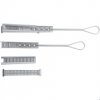I've seen a handful of references on this board to running aerial cable. Though it's never the best choice, sometimes it may be the only choice, so I thought I'd make a comment or two about installation.
Using Ethernet cable with a built-in steel support strand is a must, and you can't just put it up like a clothesline. Both ends of each span need to be attached with strain relief.
This applies to a span of just a few meters from rooftop to pole as well as to pole-to-pole spans up to the maximum rated spec of 70 meters.
As a lineman back in pre-history for Ma Bell, the two-conductor drop wire we used was very tough and nearly flat. Self-tightening clamps were perfect for that cable, but they cannot be used on Ethernet wire which is round and not nearly so tough.
There are plastic roundabout clamps that are popular these days but they too are no good for Ethernet. Their S-curves are too small and thus violate the 2cm radius rule. A tight turn is exactly the wrong place to apply the weight of a long span.
There may be clamps especially designed for use with support-strand Ethernet cable but they're not available to me here in this "developing" country. So, what to do?
The answer is to make use of the support strand itself. If you are going from span to span, use something like a dull butter knife to carefully separate about 12 inches of the support wire from the rest of the cable. Bend the steel wire with pliers to form a loop that can be hung on the J-hook or whatever is on the pole. The Ethernet part of the cable will form a gentle loop that is well withing the comfort zone of the inner conductors.
For a span from pole to house, you might want to remove the support strand for the remaining distance from the entry point to it's termination at a POE NVR or POE switch.
One variation on this method is to do as described but then add the use S-curve strain relievers. Wrap the support strand securely around the curves and use the clamp's hook to hang the wire. This was my choice for the 38 meter span and 5 meter drop that I hung two years ago. It's done well in all kinds of tropical storms and that's a relief to me; hanging wire is hard and risky work, don't want to have to re-do it.


Using Ethernet cable with a built-in steel support strand is a must, and you can't just put it up like a clothesline. Both ends of each span need to be attached with strain relief.
This applies to a span of just a few meters from rooftop to pole as well as to pole-to-pole spans up to the maximum rated spec of 70 meters.
As a lineman back in pre-history for Ma Bell, the two-conductor drop wire we used was very tough and nearly flat. Self-tightening clamps were perfect for that cable, but they cannot be used on Ethernet wire which is round and not nearly so tough.
There are plastic roundabout clamps that are popular these days but they too are no good for Ethernet. Their S-curves are too small and thus violate the 2cm radius rule. A tight turn is exactly the wrong place to apply the weight of a long span.
There may be clamps especially designed for use with support-strand Ethernet cable but they're not available to me here in this "developing" country. So, what to do?
The answer is to make use of the support strand itself. If you are going from span to span, use something like a dull butter knife to carefully separate about 12 inches of the support wire from the rest of the cable. Bend the steel wire with pliers to form a loop that can be hung on the J-hook or whatever is on the pole. The Ethernet part of the cable will form a gentle loop that is well withing the comfort zone of the inner conductors.
For a span from pole to house, you might want to remove the support strand for the remaining distance from the entry point to it's termination at a POE NVR or POE switch.
One variation on this method is to do as described but then add the use S-curve strain relievers. Wrap the support strand securely around the curves and use the clamp's hook to hang the wire. This was my choice for the 38 meter span and 5 meter drop that I hung two years ago. It's done well in all kinds of tropical storms and that's a relief to me; hanging wire is hard and risky work, don't want to have to re-do it.




